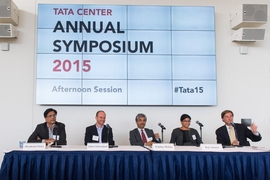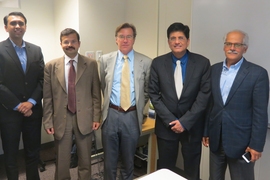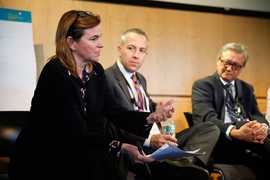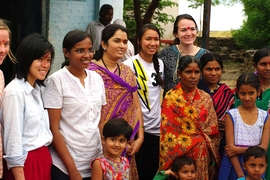When James Wescoat made his first research trip to India more than 40 years ago, it was to study the impressive waterworks of the bygone Mughal Empire — an experience that fueled his fascination with the utility, cultural significance, and beauty of water. But he also saw firsthand how a poor modern-day water infrastructure was hindering the nation’s progress.
“Several decades ago, water and sanitation were the leading cause of death for children under five years old in India, and a major deficiency in village quality of life,” he says. “It was especially onerous for women, because it meant very long journeys to fetch water.”
Over the years, he has seen India increase its commitment to providing clean water coverage nationwide, but many challenges remain. Now, as the Aga Khan Professor of Architecture at MIT, Wescoat is leading a team of researchers supported by the Tata Center for Technology and Design, who are taking a multi-disciplinary approach to improving India’s water systems, including strategic planning, sustainability, and drought resilience.
“The lesson from history is that there’s a lot of water, and if it’s conserved well, through careful management, drinking water should not be a problem,” Wescoat says. “But there are questions about the sustainability of systems and institutional support. Those are some of the key sources of concern today.”
The team is focusing their efforts on rural areas, where 70 percent of India’s population resides, and on fast-growing peri-urban zones, the transitional areas outside of large cities where the urban and rural meet.
The goal is nothing less than achieving sustainable water coverage for the 900 million residents of these areas, and thanks to breakthrough thesis research by Marianna Novellino SM ’15, they are closer than ever to monitoring and evaluating water systems at a large scale.
Unearthing buried data
At the outset, Wescoat and his team knew that they wanted to support the government in making sound policy decisions, but they weren’t sure how; after all, managing water delivery across India’s widely variable social, political, and geographical terrain is a monumentally complex task.
Novellino, formerly a Tata Fellow and now a research affiliate with Wescoat’s group, wanted to combat “slipback” — a phenomenon in which infrastructure or planning projects are created, but not maintained. But to do this effectively, she needed fine-grained data, which is in short supply in most countries.
It was only after several trips to India that Novellino found what she was looking for: the Integrated Management Information System (IMIS), a database that has been collecting information on water infrastructure nationwide since 2009. The IMIS turned out be a treasure trove of data, but was not being used analytically to inform a coherent vision for water in rural India.
“The IMIS is perceived [by officials] as a requirement to get funding from the central government, but not as a source of data for their use and benefit,” she says. “My focus is on sustainability, so I said, ‘How can I leverage this, combined with a sustainability framework, to assess the performance of water supply systems in India?’”
In her thesis, Novellino details a platform for analyzing and visualizing rural water supply in India, giving policymakers a way to understand their current systems and plan improvements. The next step is simple but ambitious.
“I want to create a software tool that would enable the national goal of sustainable water supply for all,” she says. “The impact of this [in the rural sector] is 900 million people. It’s a simple tool, but it’s a lot of data that we can’t digest without help. It’s a technology that will enable better policy.”
Wescoat and Novellino have entered a formal partnership with the World Bank and the state of Maharashtra, where the competing water-use demands of agriculture and domestic consumption are a hot-button issue, and they plan to begin testing, implementing, and rolling out their data visualization tool in the winter and spring of 2016.
“The government has been very receptive,” Novellino says. Wescoat agrees, saying, “We’ve never had this kind of collaboration. It’s a high level of cooperation.”
Meanwhile, the sustainability project is just one piece of a larger puzzle being assembled by Wescoat’s group.
“Rich in diversity and challenges”
Rebecca Hui is a first-year Tata Fellow in the Department of Urban Studies and Planning who arrived at MIT having had what she describes as a “four-year love affair with India.” As a Fulbright scholar and independent researcher, she pursued her interest in urban morphology, social entrepreneurship, and the interaction of animals with the urban environment in Mumbai and Ahmedabad.
Now she’s turning her attention to developing a spatial design understanding of peri-urban areas, where water stress is often most acute. “It’s an area that’s very relevant for India in the future,” she says. Wescoat adds, “It’s one of the most difficult environments, because it has all the pressures of urban life and little of the infrastructure or resources to deal with the demands.”
Paige Midstokke, a first-year Tata Fellow in the Engineering Systems Division, is investigating issues of water scarcity and drought resilience. Hailing from California, and having studied water scarcity in refugee camps in Southeast Asia, it’s an issue close to her heart.
“I want to understand how to plan for drought,” she says. “I’m looking at predictive analytics approaches and best practices for conservation and serving demand during times of scarcity.”
Anisha Anantapadmanabhan, a graduate student in urban studies and planning, is the final member of the team. A Mumbai native, she says “going back to Mumbai with the lens of city planning has been really interesting. We’re trying to provide a little bit of insight and assistance to deploying resources in an efficient manner, and we’re thinking about strategic outcomes.”
Myriad partners provided vital resources and connections at various stages of the project. In addition to the government of India, and the states of Gujarat and Maharashtra, Wescoat’s team has worked with Aga Khan Planning and Building Services, the Tata Trusts, and the National Informatics Center, which owns the IMIS.
“In India it’s about how you adapt institutional and social behaviors to make solutions scalable and available,” Novellino says. “If you understand the institutions, you allow other technologies to come in and help. That’s where we see the value of our group.”
Wescoat is excited to see where these research paths take them. “This domain is unbelievably rich in its diversity and challenges.”











